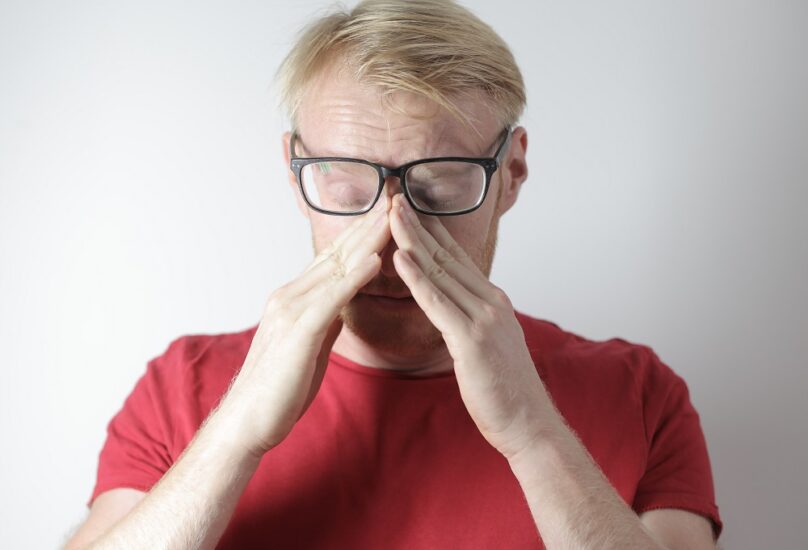Home remedies to get rid of sinusitis

What are sinuses?
The sinuses are a connected structure of hollow cavities within the skull. The largest sinus cavities are almost an inch across, while other sinuses are much smaller.
- The cheekbones hold maxillary sinuses, which are the largest.
- Frontal sinuses are located at the low-centre-of our forehead.
- Ethmoid sinuses are between our eyes.
- Sphenoid sinuses are behind the nasal bones.
The sinuses are covered with pink tissue called the mucosa. Usually, the sinuses are empty cavities; only a thin layer of mucus is present.
The inside of our nose has ridges called turbinates. Generally, these turbinates help to humidify and filter the air that we breathe. There’s a thin wall known as the septum, divides the nose. Sinuses clear into the nose through a small canal known as the “middle meatus.” Sinuses usually keep the nasal passages moist and trap any dirt particles or germs.
What is sinusitis?
A sinus infection, commonly known as sinusitis, is the infection causing the sinuses and nasal passages to get inflamed, and this inflammation is called sinusitis. From time to time, bacteria or allergens form too much mucus blocking the openings of your sinuses, leading to sinusitis.
Having excess mucus is common when catching a cold or allergies. The mucus buildup can become thick as the bacteria and germs start to accumulate in the sinus cavity, resulting in a bacterial or viral infection. Generally, sinus infections are viral and get cured in a week or two without any treatment.
What are the risk factors of sinusitis?
These factors can increase an individual’s risk of developing sinusitis:
- Previous respirational tract infection, such as a cold
- Nasal polyps – Small benign growths in the nasal passage that can lead to obstruction and cause inflammation
- history of seasonal allergies
- sensitivity or allergic to substances such as dust, pollen, and animal hair
- having a weakened immune system because of certain medication or a health condition
- I am having a deviated septum (septum is the bone and cartilage that divides the nose into two nostrils. It becomes bent on one side, either due to injury or growth, hence can increase the risk of sinusitis).
- having tooth infection
What are the symptoms of sinusitis?
The symptoms of sinusitis keep fluctuating depending upon the condition that lasts. The symptoms are:
- nasal discharge may be green or yellow
- a postnasal drip (mucus runs down the back of the throat)
- facial pressure or pain
- runny or blocked nose
- sore throat and cough
- bad breath
- fever
- headaches
- Down the sense of smell & taste
- Swelling around the eyes, nose, cheeks, and forehead
- toothache
What are the types of sinusitis?
Acute sinusitis – Acute sinusitis is the sinusitis having the shortest duration of infection. A viral infection that is mostly caused by the common cold can cause acute symptoms that generally last for one to two weeks. If the sinusitis is due to a bacterial infection, then it may last for up to 4 weeks. Seasonal allergies can also cause acute sinusitis in some people who are at risk.
Subacute sinusitis – Subacute sinusitis symptoms usually last for up to three months. This sinusitis is caused due to bacterial infections or seasonal allergies.
Chronic sinusitis – Chronic sinusitis symptoms generally last above three months. Bacterial infections are the main issue of this type of sinusitis. Also, chronic sinusitis occurs often with persistent allergies or nasal structural problems.
Recurrent sinusitis – It means that the person can have several sinusitis attacks every year.
What tests are done to diagnose the cause of sinusitis?
Sinusitis is mostly diagnosed based on the history and examination of a doctor. However, in cases of chronic infection, the doctor usually recommends imaging tests to examine the nasal passages and sinuses. These tests can show the extent of mucus blockages and any abnormal structures, such as polyps.
A plain X-ray can show problems with the bones around the sinuses; however, the CT scan is better. A CT scan or MRI provides a detailed picture of your sinuses.
What are the ways to get rid of a sinus infection or sinusitis?
Acute sinusitis symptoms usually do not last longer than ten days, and chronic sinusitis might last for 12 weeks or longer. Sinusitis always gets better on its own. However, there are a few things one can try to fasten the recovery process.
Drink plenty of water
Drink enough water and make sure that you are adequately hydrated to help flush the infection out of your system. Drink at least 8 ounces or half a litre of water every 2 hours.
Have foods with antibacterial properties
Add antibacterial foods such as garlic, ginger, and onions to your meals to fight the viral infection. Also, try drinking ginger tea and add raw honey as it is full of antioxidants along with antibacterial and antifungal properties.
Take steam and use the nasal spray
- During the day/ before going to sleep, use natural saline nasal sprays. Use it several times a day to break up the nasal congestion.
- Take steam inhalation and regular hot showers and breathe in the damp air. Fill a glass with hot water & bend over it for 10 minutes. Cover your head and the bowl with a towel so that the steam should not escape. Keep your nose 8-10 inches above the hot water.
- During the night, sleep with a humidifier to help relieve the nasal blockages during sleep.
Use essential oils
Eucalyptus oil is beneficial in opening up the sinuses and getting rid of the mucus. Use eucalyptus oil externally on the temples or chest, or inhaled using a diffuser by adding few drops of oil to boiling water.
Try using a neti pot.
Nasal irrigation using a neti pot is used to ease the symptoms of sinusitis. Fill the neti pot with the saline solution and bend your head over the sink at a 45-degree angle. Place the spout of the pot/glass into the top nostril and cautiously pour the saline solution into that nostril. Repeat it for the other nostril.
Use warm compresses to ease facial pain.
Place warm or damp towels around the nose, cheeks, and eyes to ease the facial pain. It will also help in clearing the nasal passages.
Get enough rest
A good sleep at night can help the body to heal faster. Try to avoid activities or drinks that are over-stimulating before bed. Elevate your head while sleeping as it will prevent sinus buildup and can help you to breathe more easily. Lying flat increases the mucus buildup in the nasal passages and increases the sinus pressure, disrupting the sleep cycle.
Over-the-counter (OTC) medications
If home remedies are not giving you relief, then ask your doctor to suggest an OTC treatment that may relieve sinusitis symptoms.









Comments are closed.